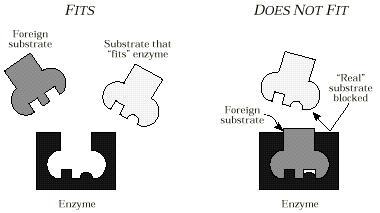
2. Draw a picture of an enzyme molecule showing
its
active site.

3. Draw a picture of a substrate molecule that
‘‘fits” the active site of an enzyme, and
one
that does not “fit.”

Pattern Recognition
1. Enzymes were previously named by adding the
suffix -ase to the name of the
substrate upon which they acted. For
example:
-
Sucrase is the enzyme that acts to break down sucrose.
-
Lipase breaks down lipids.
-
Peroxidase breaks down peroxides.
2. Enzymes are now properly classified according to the type
reaction they
catalyze. The classes include:
-
Oxido-Reductases involve donating and accepting electrons.
-
Hydrolases add water to break chemical bonds. (Most digestive enzymes
are in this category.)
-
Transferase transfers groups (amino, phosphate, carboxyl, etc.)
from one molecule to another.
-
Lyases break (or form) double bonds.
-
Isomerases change one isomer into another.
-
Ligases allow C—C, C—N, and C—S bond formation.
Problem Solving/Decision Making
1. Humans cannot digest wood, paper, and other
cellulose materials because
cellulase, the enzyme required to break
these materials down into usable
glucose, is not present in the body.
It is produced by bacteria that live in the
intestinal tracts of termites, horses,
goats, etc. Suppose that someone suddenly
found a way for this enzyme to exist
in humans. Reflect on the wide
implications of such a possibility,
and write a short paper describing what
effect this might have on humans.

